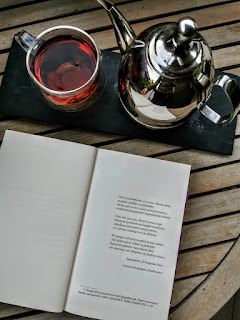Straszna noc
Święta noc jest kontynuacją Dziecka piasku, choć można
je czytać również zupełnie osobno. Tahar Ben Jelloun oddaje głos Zahrze, tym
razem pozwala jej samej opowiedzieć swoją historię. Nie jest ona wcale prostsza
do zrozumienia niż w poprzednim tomie, i znów mam wrażenie, że spora część
kulturowych odnośników pozostaje dla mnie nieczytelna.
Stawanie się kobietą
Zahra po śmierci ojca porzuca dom rodzinny i rusza na wędrówkę. Najpierw z
Szejkiem trafia do krainy dzieci, która jest jednocześnie krainą zapomnienia.
Zahra odkrywa tam swoją kobiecość, ciało, jego pragnienia. To kontynuacja
przeobrażenia, które zaczęło się na grobie ojca, gdzie Zahra pogrzebała również
swoje alter ego, Ahmeda – oraz całą dokumentację, bandaże krępujące jej piersi,
męskie ubranie. Tego procesu nie da się już zatrzymać. Dziewictwo odbiera jej
bezimienny mężczyzna w lesie, któremu dziewczyna nie ma siły się przeciwstawić.
Szukając miejsca do obmycia się trafia do łaźni, którą opiekuje się Krępa, i
tak trafia do domu łaziebnej i jej niewidomego brata, Konsula. Dziewczyna
nawiązuje intymną relację z mężczyzną, ale jego siostra jest o to zazdrosna, i
Zahra musi opuścić bezpieczne schronienie. Zwłaszcza, że zaczyna ścigać ją jej
rodzina, a zwłaszcza zgorzkniały i roszczeniowy stryj, który chce zagarnąć
rodzinny majątek. Zahra zabija go, za co zostaje skazana na 15 lat więzienia.
Kiedy wydaje jej się, że w więzieniu odnalazła spokój, a nawet pewnego rodzaju
szczęście, dopadają ją jej mściwe siostry, i na żywca wycinają jej łechtaczkę i
zaszywają pochwę. To jedna z najbardziej wstrząsajacych scen w literaturze,
które czytałam. Potworna.
Kobieta kobiecie
Znów, tak jak w Dziecku piasku, przeraża sytuacja kobiet w
muzułmańskiej kulturze. Matka Zahry modli się, by dane jej było przeżyć choć
kilka dni po śmierci męża, by mogła zasmakować wolności. Kobiety sobie
zazdroszczą, pilnują siebie nawzajem, rywalizują, mszczą się na sobie. Scena,
gdy cztery siostry dopadają Zahrę w więzieniu, by ją okaleczyć, niesie w sobie
niewyobrażalne, nieprawdopodobne okrucieństwo, bo robi to kobieta – kobiecie,
siostra – siostrze.
Obca kulturowo twórczość
Nadal mam wrażenie, że nie w pełni rozumiem twórczość marokańskiego pisarza.
Zakończenie książki, gdy Zahra po wyjściu z więzienia znów trafia na Krępą,
której towarzyszy przemieniony Święty – Konsul, pozostaje dla mnie zagadką. Styl
Ben Jellouna ma w sobie pewien mistycyzm, autor dużo operuje obrazami,
odczuciami, czytelnikowi wyostrzają się zmysły, jakby sam był ślepcem. Czy
jednak widzi się więcej oczyma duszy? Ja nie zobaczyłam.
Moja ocena: 7/10.
Tahar Ben Jelloun, Święta noc
Wydawnictwo Karakter, Kraków 2014
Tłumaczenie: Jacek Giszczak
Liczba stron: 200
ISBN: 978-83-927366-52-0
*********************************************************************************
Scary night
The Sacred Night is a
continuation of The Sand Child, although it can also be read completely
separately. Tahar Ben Jelloun gives voice to Zahra, this time allowing her to
tell her story by herself. It is no easier to understand than in the previous
volume, and again I have the impression that a large part of the cultural
references remains illegible to me.
Becoming a woman
After the death of her father,
Zahra leaves her family home and goes wandering. First, with Sheikh, she goes
to the land of children, which is also the land of oblivion. There, Zahra
discovers her femininity, her body, and her desires. This is a continuation of
the transformation that began at her father's grave, where Zahra also buried
her alter ego, Ahmed – along with all the documentation, the bandages binding
her breasts, the men's clothes. This process can no longer be stopped. Her
virginity is taken from her by an unnamed man in the forest, whom the girl has
no strength to resist. While looking for a place to wash, he comes to a bath
house looked after by the Seated Woman, and so he ends up in the house of the
bath maid and her blind brother, the Consul. The girl begins an intimate
relationship with the man, but his sister is jealous, and Zahra has to leave
her safe haven. Especially since her family begins to pursue her, especially
her bitter and demanding uncle who wants to take over the family fortune. Zahra
kills him, for which she is sentenced to 15 years in prison. Just when she
thinks she has found peace and even some kind of happiness there, her vengeful
sisters find her, cut out her clitoris and sew up her vagina. This is one of
the most shocking scenes in literature I have read. Monstrous.
Woman to woman
Again, as in The Sand Child,
the situation of women in Muslim culture is terrifying. Zahra's mother prays
that she will be allowed to live at least a few days after her husband's death,
so that she can taste freedom. Women envy each other, watch each other,
compete, and take revenge. The scene when the four sisters catch Zahra in
prison and mutilate her carries unimaginable, unbelievable cruelty, because it
is done by a woman to a woman, a sister to a sister.
Culturally alien work
I still have the impression that
I do not fully understand the work of the Moroccan writer. The ending of the
book, when Zahra, after leaving prison, comes back to the Seated Woman,
accompanied by the transformed Saint - Consul, remains a mystery to me. Ben
Jelloun's style has a certain mysticism to it, the author uses a lot of images
and feelings, the reader's senses become sharper, as if he were blind himself.
But does one see more with the eyes of the soul? I certainly didn't.
My rating: 7/10.
Author: Tahar Ben Jelloun
Title: The Sacred Night
Publishing House: Karakter, Kraków 2014
Translation: Jacek Giszczak
Number of pages: 200
ISBN: 978-83-927366-52-0
















































